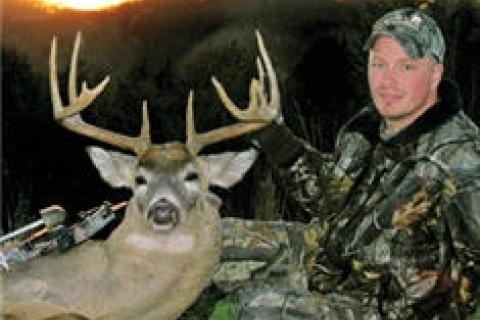
The biggest bucks are never pushovers—even Now. Let a Mississippi expert teach you How to tag a breeding- season giant.
Article by Scott Bestul.
 |
| Photo of whitetail courtesy of Bass Pro Shops |
Most hunters believe the rut is the one time when mature whitetails lose their caution. Ronnie Foy doesn't buy it. "Everyone thinks they'll see a monster in a beanfield during the middle of the day then,” says Foy (at right), the owner of Foy’s Guide Service in Canton, Miss. (601-859-2300). “That happens just enough to fool folks into thinking it’s typical. Sure, the rut will put a buck on his feet more during the day, but he’s going to move between protected food sources—both to eat and find does—where he doesn’t expose himself. Those spots are in the woods.”
• So how do you score? Follow Foy’s instructions here.
??#1: Find the Hidden Calories ?“Knowing the native food sources located within the woods, as well as when they’re most attractive to deer, is critical,” Foy stresses. “Sometimes natural foods—especially acorns—will be so hot that deer will focus on them exclusively.” In Foy’s area, blackberry leaves, poke salad, honeysuckle, hydrilla, and kudzu are other whitetail favorites. And bucks may favor one over another depending on the weather. “When it’s hot and dry, our deer eat hydrilla in creekbottoms, where temperatures tend to be cooler.” ??
#2: Pinpoint Cover and Water ?Not all feeding areas are created equally, according to Foy. “A big buck will favor those adjacent to security cover.” When you find feeding sign not far from dense conifers, thick brush, tangled brambles, or other young growth, you’ve got a solid stand location. And if you can find this, plus nearby water, he says, you’ve got the perfect site. “Deer view water as security, a place they instinctively run to escape predators. Any time I can find a natural food source next to dense bedding cover and water, I know I’m in the right spot.”
??#3: Final Exam ?“Any hot hidden food source will work, but if we get a cold snap as the rut starts up, nothing beats oaks,” Foy says. Feeding sign should make it obvious which trees whitetails are focusing on, but rubs are the key. “Big rubs nearby mean a big buck is feeding and looking for does there. But remember, you don’t always have the right tree species for these. That’s when I walk the edge of the closest thicket. If every clump of brush is torn up, I know a good buck has claimed the area as his own.”
Set up just off the rubs or trashed brush, expecting your buck to travel along the edge of security cover. “People think bucks stay in the thick stuff,” Foy says. “I’ve found that they tend to stay on the periphery.” When there’s more than one thick-cover edge, cheat toward the water. “That’s the side the buck will favor.”
Hunt carefully. “Don’t assume a rutting buck is less wary. The minute a mature deer senses you’re on him, it’s game over for you.” Wait for the right wind and get in silently, though, and it’s game over for that trophy.
Originally published on the Field & Stream Rut Report: A Whitetail Deer Season Tracker
Published here with permission from Field & Stream
- 3492 views

